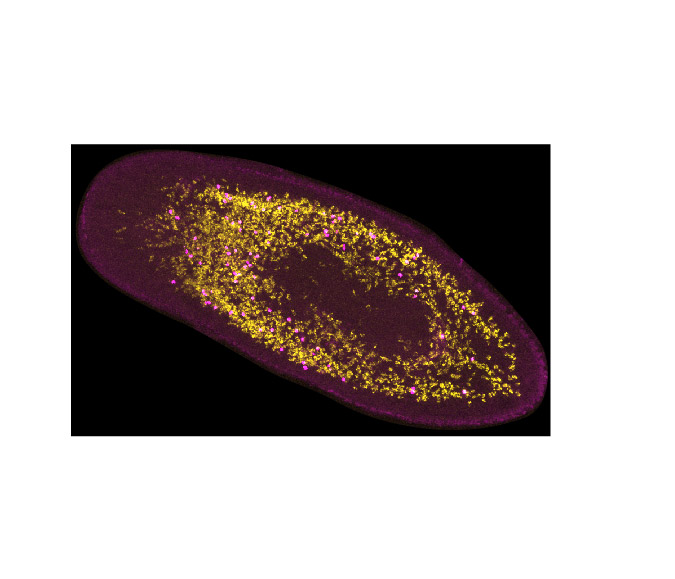CVM study unlocks stem cell superpower in flatworms
Planarian flatworms can regenerate new heads, tails, or entire bodies thanks to their vast amounts of pluripotent stem cells, cells that can essentially become any cell in the body. While humans have these cells too, they’re highly limited in number. So, scientists use planarians to better understand these superpowers. In a recent publication, researchers at the Cornell University College of Veterinary Medicine have uncovered the mechanism behind stem cell death due to radiation treatment, and how one gene can dictate the fate of these cells after exposure to DNA damage.
“Planarians are known to be an amazing organism because their bodies are 20% stem cells,” says Dr. Carolyn Adler, senior author and assistant professor in the Department of Molecular Medicine. “I was really fascinated and wanted to understand the underlying genetic and cellular mechanisms that control these stem cells.”

In nearly all animals, if a cell passes on genetic mutations, typically the result of DNA damage, to its progeny during cellular division, it can cause the growth of cancerous cells that replicate indefinitely. To avoid passing on such mutations, cells must pass rigorous check points, where mutated cells will be destroyed. While this process may have good intentions, it can unnecessarily kill good, healthy cells, including stem cells. That may be fine in the flatworms, with their abundant amount of stem cells, but could be detrimental in humans who have a limited supply of these specialized cells.
The lab first started exploring how stem cells respond to mutations caused by extremely high levels of ionizing radiation. This form of radiation causes the DNA strands to break, in which the cell is alerted that something is wrong. Co-first author Divya Shiroor, Ph.D. '22, saw that upon physical injury to the worms, the stem cells could withstand radiation treatment longer than worms without a wound. They found that the injury forces the worms to start regenerating, a process that heavily relies on stem cells, and therefore, the stem cells repair the radiation damage and survive instead of being disposed of.
Three enzymes dictate the fate of the stem cell upon DNA damage in most species, including humans: Ataxia-Telangiectasia Mutated (ATM), Ataxia Telangiectasia and Rad3-related (ATR), and DNA-dependent protein kinase (DNA-pk). ATM and ATR serve as important checkpoint regulators that halt the cell cycle after detecting this DNA break, acting as guards that need to inspect the integrity of the cell before allowing it to continue to grow.
“We kind of describe ATM as like the executioner under normal circumstances. Because planarians have so many stem cells, that can divide rapidly, they're basically disposable. Whereas in humans, stem cells rarely divide and are like a special entity that needs to be retained and protected,” says Adler.
Co-first author Kuang-Tse Wang, Ph.D. student in the Adler lab and studying in the field of Genetics, Genomics and Development, was keen on discovering how these enzymes function in stem cells after DNA damage. To do this, he compared the effects of using extremely high-levels of radiation exposure on wild-type worms to those genetically altered to lack the ATM enzyme. He found that after the otherwise lethal radiation exposure, wild-type worms perished due to the loss of their stem cells. However, worms that were missing ATM survived, suggesting that ATM is responsible for sacrificing the DNA-damaged cells, and without it, the cells were able to find a way to overcome this damage.
“It was remarkable,” says Adler. “That we could so robustly prevent stem cell death – nobody had ever done this before.”
On top of this initial observation, the researchers discovered that the radiated planarians could survive long term after radiation treatment only when ATM is missing. Compared to wild-type worms which are unable to recover after DNA damage, ATM mutant worms had a 90% survival after six weeks. This demonstrates the animal’s ability to correct the damaged DNA and replicate normally only when the strict ATM check point guard is gone.
To test if the previously damaged stem cells were still able to become new cell types, the researchers decapitated the heads of the worms after radiation treatment and examined the potential for the stem cells to regenerate the missing head. They found that 80% of the worms that were missing ATM were able to fully regenerate all the necessary components of the head, including photoreceptors and the central nervous system, proving the repaired stem cells can still differentiate into various cell types.
“It was surprising that by just getting the cells to survive that initial [radiation] insult, they seem to be able to repair and recover all of their normal activity,” says Adler. “This is really a counterintuitive result.”
It is known that when mammalian ATM is absent, stem cells age prematurely and after they divide several times, become exhausted. In planarians, when ATM is missing and DNA damage occurs, the opposite happens – that the stem cells rejuvenate and can divide indefinitely. The Adler lab is excited to tease apart this mysterious mechanism in the future.
Overall, these discoveries open the door to elucidating the role of checkpoint proteins and DNA repair pathways in these fascinating stem cells.
Written by Megan Keller




